

Purchasing an HP-35 Calculator in 1972
© 2023 Al Fenstermaker
This is a new article which was not originally in "The International Calculator Collector".
In 1972 Al Fenstermaker was one of the first students to purchase a Hewlett-Packard HP-35 scientific calculator.
Here he tells the fascinating story of how this came about
In 1969 I was in 9th Grade in the Seattle area taking a class called "Math Machines", where we learned the basics of computer programming. My school had two BASIC
terminals connected to mainframes at the University of Washington as well as access to the IBM 360 Mainframe that the school district used for administrative purposes, this gave us the ability to program in both BASIC and
Fortran. The teacher of the class was friends with an engineer at HP and he told me about a calculator that HP was developing at the time and it sounded like an amazing machine to me.
My interests were in
chemistry and at the time I was building up a laboratory in my parent's basement, and although my intent was to go to college and major in Chemistry, I knew math was one of my weaker subjects and I'd have to work very hard to
overcome that deficiency.
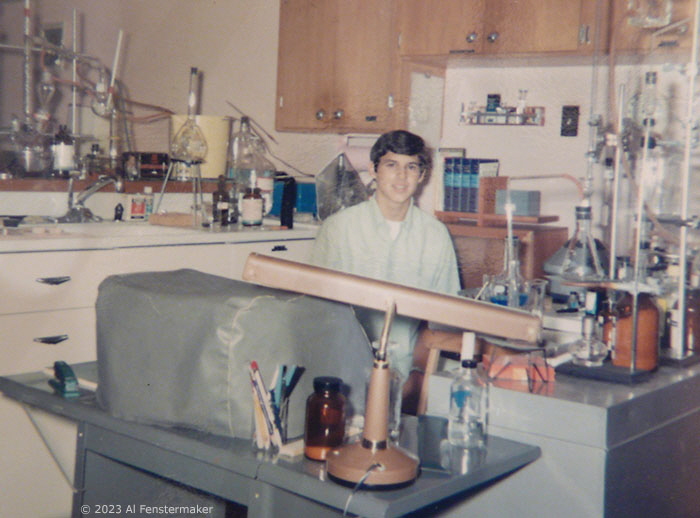
Me in my lab taken by my father in 1969. My interest was always chemistry, but that class in 1969 was all about computer programming. I knew programming was going to be a very important area during my career timeframe, but I was hooked on "Plastics", recall the line in the movie "The Graduate". An interesting point is this lab was in our house on 161st street in the north end just outside the Seattle city limits, just down the street on 140th Paul Allen and Bill Gates were attending Lakeside School (from 1965 until 1971) and they were also using the capabilities of the University of Washington Computer systems, I wonder if we were at times competing for computer time.
The calculator my teacher had described sounded like just the advantage I needed in college. He had a pretty detailed understanding of most of the functions and the basic
layout of the calculator, so compared to my slide rule I figured it would save me an immense amount of time in school in math, chemistry and physics.
I kept an eye on product announcements since I could not really
just call HP and ask about a calculator that had not been announced, I did not want to get my teacher in trouble and it was clear to me even at my age he'd told me something that would have been very sensitive information to
HP. I do not remember exactly when I saw an official announcement about a new HP calculator, but eventually one was made and what they were calling the HP-35 sounded exactly like the machine my teacher had told me
about. We had an HP sales office in Bellevue, just east of Seattle and my mother drove me there to see if I could purchase one.
The process was pretty interesting as we were assigned an "Engineer" to
walk me through the HP line of computers including what at the time were called "mini" computers, bigger than a desk top, but way smaller than a mainframe. After going through all the machines they had the Engineer went and
got a small handheld devise, the HP-35. He went through the layout, showed me the rather unusual "Reverse Polish" notation approach used inputting entries, and demonstrated a number of features like the Scientific
Notation. I have to say that even with the description my teacher had given a few years earlier, I was blown away by the capability of this little devise.
Then he gave us the "bad news", my memory might be a
bit fuzzy here, but it seemed there was priority being given to who could receive one of these calculators and it was something like critical engineers in industry/Government and then certain people in academia before the general
public, and I was in the general public category. This meant I'd be on a waiting list, so we waited. Finally in November of 1972 we got the call from the HP office in Bellevue that my calculator had arrived. It's
interesting that the calculator was shipped from the factory with my name on the invoice, but the address was the HP office in Bellevue, bear in mind I had not paid for the calculator yet.
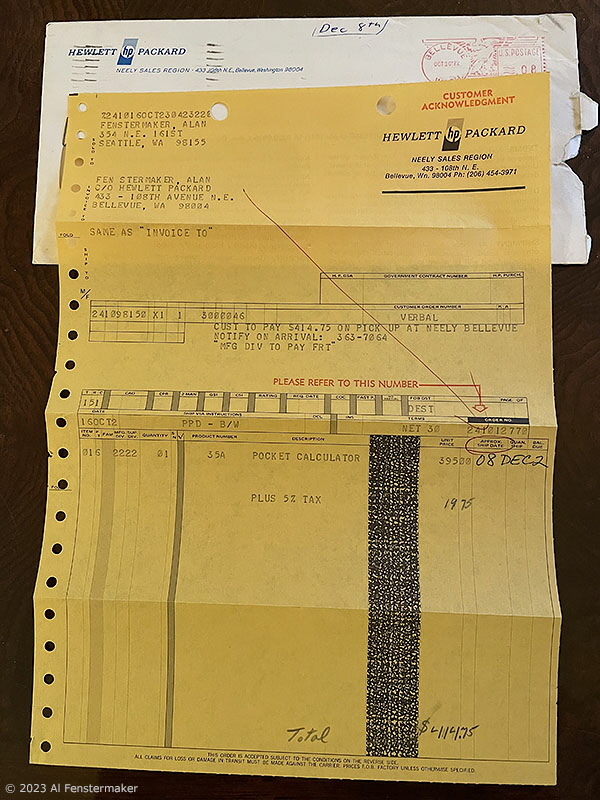
The invoice for collection of the HP-35. To Alan Fenstermaker, C/O Hewlett Packard.
By this time I had entered the University of Washington and was in my first Quarter as a Chemistry major taking my first Honors Chemistry class. It was just before finals as my mother and I went back to the HP office to pick up and pay for my new calculator, $414.75 with tax. This was an enormous sum of money for me and amounted to about a third of the money I had saved to pay for college, but I had no doubt about it's value for me in the next few years of college and my mother wrote the check.
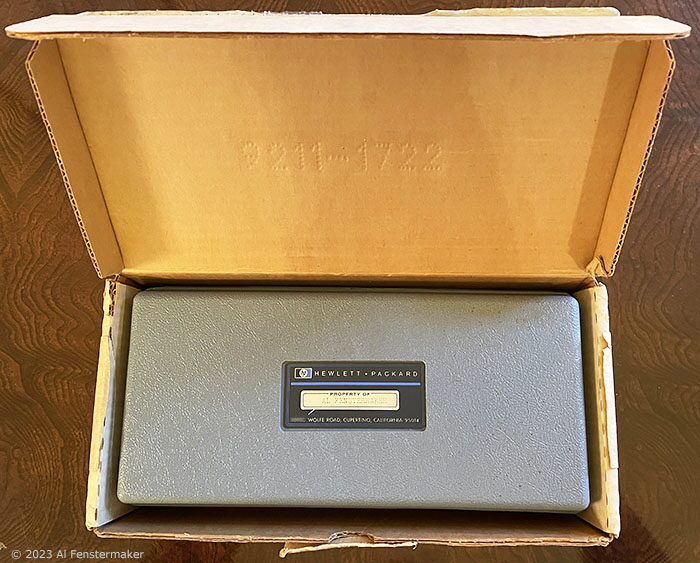
Opening the carton that was presented revealed the hard protective case containing the HP-35 calculator.
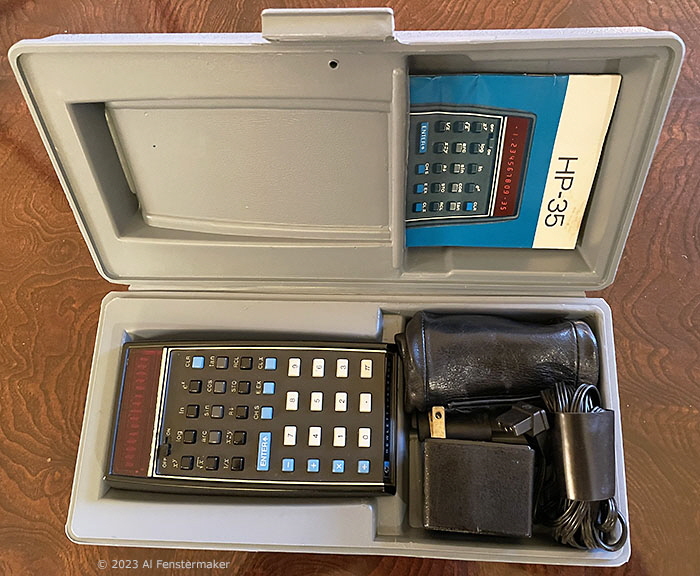
Inside the hard case was the HP-35 calculator, operating instructions, soft carrying case and AC charger.
The following days were spent studying and at the same time learning to use the HP-35, especially any functions I might need during finals. It was not just that I needed to know how to use it, but to be able to use it quickly under the pressures of the University exam's environment. By the time my first exam came up I felt I was ready and this was a math exam, but I still decided I'd better take my slide rule just in case I couldn't remember something needed with the calculator. I'd spent many days and many hours with the HP and it had performed flawlessly, I'd also kept it to myself that I had this device because I did not have time to show and demonstrate it to all the people that would have been interested. In the Fall of 1972 (as far as I knew) there were 4 HP-35s on the University of Washington campus, the Chemistry Dept. had one, the Physics Dept. had one, the Medical School had one, and I had one. For testing at that time both slide rules and calculators were allowed, but most handheld calculators at the time could only do addition, subtraction, multiplication, division, and maybe square roots, nothing like the power I had with me.
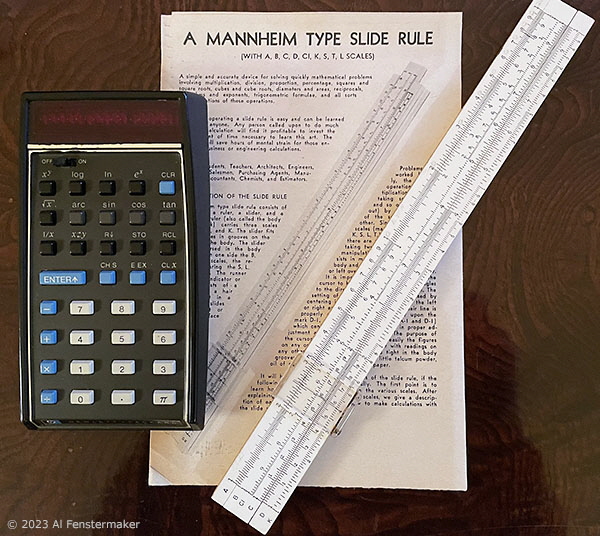
The HP-35 'electronic slide rule' calculator alongside the trusty conventional slide rule, a useful backup which did not require a battery.
The test was handed out and I started working the problems using the HP, but shortly into the test the calculator went "dead" and I pulled out my trusty slide rule to
finish it. I called the engineer at HP in the office in Bellevue and he told me that "sometimes you get a bad battery" and that's likely the case here. He let me know he'd get me a new one but it would take a while,
well awhile meant Final Exams would be over before my calculator was back in operation.
Over the next few years the HP-35 proved it's value numerous times for me and my friends, the TI-51 began to show up on
campus, eventually the price of the HP-35 began to drop and more showed up, then newer HP models appeared, but for that critical timeframe for me from 1972 until 1976, that HP-35 was invaluable. I remember a particular
Physics exam where I finished the test in about 25 minutes for a one hour test, then I passed the calculator around to others around me so they could finish early or at least check their work, five of them got the HP advantage that
day. By the way sharing calculators was OK during tests as they were not something everyone had and the University felt if people were willing to share them with others, why not let them. From 1972 through about 1974 I
limited the number of people that knew I had the HP and I never carried it in a way that it was obvious, very quickly any science or engineering major knew what was in that little black leather case on someone's belt.
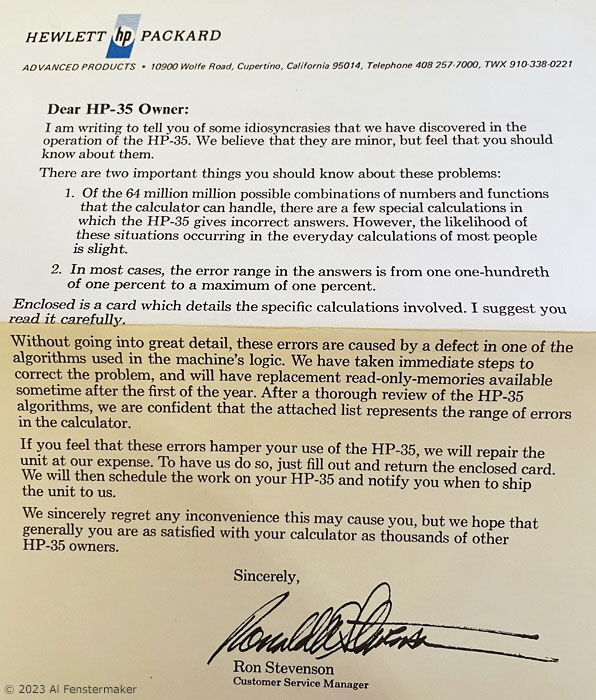
Being an early model this HP-35 had defects which had been discovered in some of the algorithms, as listed in these notes sent out.
Hewlett-Packard offered to fit replacement read-only-memories to correct the problems. Ironically, HP-35 calculators still with this defect are now sought after by collectors.
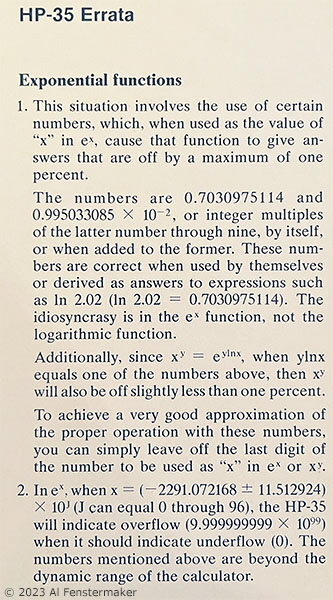
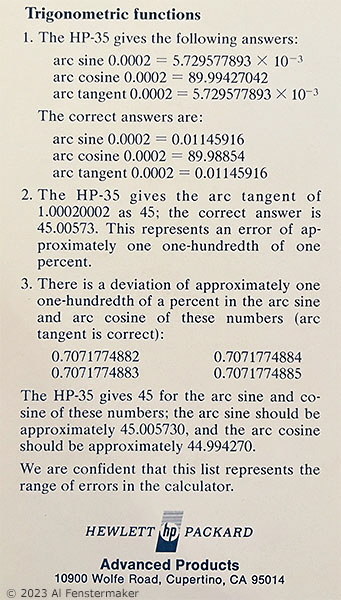
Notes explaining the errors in the algorithms. They would not have seriously affected many people.
Additional Notes:
There is a lot of interesting information available about the HP-35, including:
- The HP-35 is a featured hand-held calculator on this site. The page has a list of external websites with more information about the HP-35.
- The article "The HP-35 Calculator: The first Electronic Slide Rule", in the 'Collecting Calculators' section of this site, has further information about the HP-35.
Text and photographs in this article © 2023 Al Fenstermaker
Calculator Articles
Vintage Calculators
Text & photographs copyright, except where stated otherwise, © Nigel Tout 2000-2026.